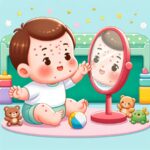When it comes to our little ones, their well-being is our top priority, and dermatitis is a common concern among new parents. Dermatitis is an inflammation of the skin that can cause discomfort and distress in babies. This comprehensive guide aims to demystify dermatitis, offering valuable insights into its causes, symptoms, and treatments, ensuring your baby’s skin stays healthy and happy.
What is Dermatitis?
Dermatitis is a broad term used to describe a range of skin conditions that result in inflamed, irritated skin. It can present itself in various forms, such as atopic dermatitis (commonly known as eczema), contact dermatitis, and seborrheic dermatitis. Each type has its own set of triggers and symptoms, but they all share a common feature: inflammation of the skin. It’s crucial to identify the type of dermatitis your baby is experiencing to provide the most effective treatment.
Atopic dermatitis is the most common form seen in babies and is characterized by dry, itchy skin that can become red and cracked. It often appears on the cheeks, forehead, and scalp, but can spread to other areas. Understanding the signs and triggers of atopic dermatitis is a key step in managing your baby’s skin health. For a deeper dive into atopic dermatitis, consider visiting this detailed article on our site.
How to Identify Symptoms of Baby Dermatitis
Recognizing the symptoms of dermatitis in your baby is the first step towards providing relief. Look out for dry, scaly skin, redness, and areas of swelling. Babies with dermatitis may also experience itchiness, which can lead to scratching and further irritation. It’s important to observe where these symptoms occur, as different types of dermatitis tend to affect different areas of the body.
Beyond physical symptoms, dermatitis can affect your baby’s mood. Discomfort from itchiness and irritation can lead to increased fussiness and trouble sleeping. If you notice these behavioral changes alongside skin symptoms, it’s a strong indicator that dermatitis might be the cause. For tips on managing sleep issues related to skin discomfort, our article on baby sleep apnea offers excellent advice.
Treating and Managing Baby Dermatitis
Treatment for baby dermatitis varies depending on the type and severity of the condition. For many babies, a good skincare routine is the foundation of managing dermatitis. This includes regular bathing in lukewarm water using mild, fragrance-free cleansers, followed by the application of moisturizers to lock in moisture. It’s also essential to avoid known irritants that could trigger dermatitis flare-ups, such as certain fabrics or household products.
In cases where skincare alone isn’t enough, your pediatrician may recommend topical treatments, such as corticosteroid creams, to reduce inflammation and relieve itching. For severe or persistent dermatitis, a referral to a dermatologist might be necessary. They can provide specialized care, including prescription medications or therapy plans tailored to your baby’s needs. Understanding the options available can empower you to make informed decisions about your baby’s health. For more information on dermatitis treatments, check out our article on dermatitis solutions for babies.
Preventing Dermatitis Flare-ups in Babies
Prevention is always better than cure, especially when it comes to baby dermatitis. Identifying and avoiding triggers is key to preventing flare-ups. Common triggers include harsh soaps, wool clothing, sweat, and allergens. Keeping your baby’s skin well-moisturized is also crucial, as dry skin is more susceptible to dermatitis. Choose a fragrance-free, hypoallergenic moisturizer and apply it to your baby’s skin after bathing and as needed throughout the day.
Creating a comfortable environment for your baby can also help prevent dermatitis. This includes maintaining a cool, humid environment and dressing your baby in soft, breathable fabrics. Regularly washing your baby’s bedding and clothing in mild detergent can also reduce the risk of irritation. For insights into managing environmental factors that can affect your baby’s skin, visit our guide on managing baby allergies.
When to See a Doctor for Baby Dermatitis
If your baby’s dermatitis symptoms persist despite home care, or if you notice signs of infection such as fever, pus-filled blisters, or significantly increased redness and swelling, it’s important to seek medical advice. A healthcare professional can assess the severity of the dermatitis and recommend appropriate treatment. In some cases, they may suggest tests to rule out other conditions or allergies contributing to your baby’s skin problems.
Remember, you’re not alone in this journey. Many parents deal with baby dermatitis, and with the right approach, it can be effectively managed. Staying informed, being vigilant about skincare, and seeking professional advice when necessary are all steps towards ensuring your baby’s skin health. For further reading on related topics, explore our articles on baby eczema and diaper rash, which provide additional insights into caring for your baby’s sensitive skin.













